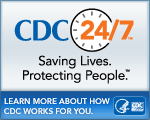State of CDC Archive
Special Features
2009
H1N1 Response
In April 2009, CDC and public health workers were suddenly faced with a serious and urgent new public health threat: 2009 H1N1. With initial reports of the outbreak coming in from Mexico and the Southwestern United States., CDC quickly mobilized against the first possible influenza pandemic in 40 years. This effort is a national priority, with direct involvement from President Barack Obama and $500 million allotted for grants for state initiatives.

DETECTION: CDC’s Influenza Division led the agency’s response to the pandemic domestically and globally, with assistance from experts at CDC headquarters and in 40 countries where we support influenza preparedness. In collaboration with the World Health Organization (WHO), CDC’s Influenza Laboratory worked to build the capacity of laboratories around the world to detect and confirm cases of 2009 H1N1. 675 laboratory kits containing 2009 H1N1 primers and probes were shipped to 138 countries. CDC staff assigned to more than 50 countries, including six Global Disease Detection Regional Centers — one in each WHO region provided real-time reports on influenza trends. The Global Disease Detection Operations Center monitored reports of 2009 H1N1 infections and associated deaths — even in countries that had not yet officially reported cases to WHO.
DEPLOYMENT: Between April and November, CDC sent over 800 experts to 35 states, 23 countries, and 20 quarantine stations to assist with field investigations, laboratory set-up and training, risk communications, mitigation strategies, case definitions, data management, logistics, clinical care, surveillance, and transmission studies. Of these, 234 were specifically sent to support H1N1 response efforts. The CDC Emergency Operations Center (EOC), managed by the Division of Emergency Operations, coordinates staff , information, and communications with state and local partners during a response. Between January and November, the EOC assisted with more than 28 domestic and international events and disease outbreaks, including the United States presidential inauguration, Salmonella typhimurium outbreak, and pandemic 2009 H1N1 influenza outbreak. As the CDC point of contact for state and local officials, EOC staff managed over 21,000 calls during this period; over 5,000 of these concerned H1N1, while others included questions about global migration, malaria, quarantine response operations, and laboratory support.

PREPAREDNESS: Planning and training are essential to improve response time during pandemic as well as other types of public health emergencies. During 2007 and 2008, CDC conducted five full-scale pandemic influenza exercises involving 21 states and more than 2,200 participants. The focus ranged from testing policies on long-term workforce requirements to discussing strategies that communities could use to lessen the effect of an emergency. From 2006 to 2008, CDC also conducted nine pandemic influenza tabletop exercises and drills involving more than 350 participants, focusing on roles and responsibilities, key policy objectives, decision making, and state and local cooperative agreements. Each exercise included planning to document strengths and weaknesses, encourage responsibility for taking corrective actions, and update and revise response preparations.
2008
CDC Responds in 2008

A week prior to Hurricane Ike making landfall, CDC’s Director’s Emergency Operations Center (DEOC) was busy preparing to send life supporting medications, communication devices, personal protective equipment, and staff to Galveston, Texas, to aid the state in responding to this natural disaster.
CDC was proud to open the doors of the DEOC in 2003; it’s staffed 24 hours, every day of the year. The facility organizes scientific and operational experts in one location during emergency response; efficiently maintains situational awareness and exchanges of public health information with international, national, state, and local partners; and helps to ensure that CDC is integrated into the National Incident Management System. This system is the federal government’s systematic plan that guides departments and agencies at all levels of government, nongovernmental agencies, and the private sector to work seamlessly in order to reduce the loss of life, loss of property, and harm to the environment during a catastrophic event. In Fiscal Year 2008, the DEOC was activated for 359 days in response to 55 domestic and 16 international events, including the multistate Salmonella Saintpaul and E.coli 0157 outbreaks, the Midwest floods, and the outbreaks of cholera and hemorrhagic fever in Africa.
A significant part of preparing the CDC workforce for a public health emergency response is planning, training, conducting exercises, and evaluating CDC’s ability to respond. In Fiscal Year 2008, CDC coordinated plans, training, and evaluation for five real world events: hurricanes Gustav, Hanna, and Ike, and the Salmonella Alamosa and Salmonella Saintpaul outbreaks. Seven CDC training exercises were conducted—including exercises for anthrax, hurricanes, and pandemic influenza—to help us improve our overall response performance. In addition, 13 agency wide exercise and response-related training events were conducted and two scenario-specific response plans were completed that evaluated and clarified the roles and responsibilities of CDC centers and offices during an incident.
CDC continually updates rosters of CDC staff in the field, checks on staff members’ safety during and after an event, and conducts communication checks for deployed staff. CDC’s DEOC Logistics’ Team alone supported 871 staff with 1,500 equipment items and provided travel services for 109 staff in the field in Fiscal Year 2008. In addition, the DEOC has around-the-clock capability to coordinate the transport of life-supporting medications, samples, specimens, and personnel anywhere in the world via contracted aircraft when commercial carriers are unable to meet response needs.
2007
CDC Detection Networks Stop Salmonella Outbreaks in Their Tracks

A third large outbreak—Salmonella Tennessee—was linked to a peanut butter plant in Georgia. A total of 425 persons were infected in 44 states, with 20% requiring hospitalization.
With more than 40,000 cases of Salmonellosis reported in the United States each year, CDC searches for ways to improve its ability to detect, report, and contain foodborne outbreaks. Last year brought many successes in these areas, including a new molecular typing system that provides a faster, easier, and more reliable method of identifying Salmonella species.
Two powerful information tools—PulseNet and OutbreakNet—worked hand-in-hand to stop several serious outbreaks of food poisoning in FY07. OutbreakNet is a network of public health epidemiologists at the local, state and federal levels who investigate foodborne and diarrheal disease outbreaks. PulseNet is the revolutionary national surveillance system coordinated by CDC that allows public health laboratories to exchange information on foodborne bacteria “DNA fingerprint” patterns.
Like detectives searching for invisible clues, the networks used DNA sampling to identify several diarrheal illnesses caused by a rare strain of Salmonella in several states and strongly linked to a puffed rice and corn snack food with a vegetable coating. CDC reported that these illnesses were caused by Salmonella Wandsworth, a strain that had never before caused an outbreak of illness in the United States. After being informed about the outbreak investigation, the company that markets the product issued a voluntary recall.
A similar multistate outbreak—this time a Salmonella serotype called Schwarzengrund—was linked to dry pet food at a single manufacturing facility in Pennsylvania. As of September 2007, 62 persons in 18 states became ill after contact with the pet food, and one quarter of them required hospitalization. The company recalled the pet food, and CDC investigators are still studying why human illness, especially among infants, is associated with dry pet food.
A third large outbreak—Salmonella Tennessee—was linked to a peanut butter plant in Georgia. A total of 425 persons were infected in 44 states, with 20% requiring hospitalization.
Critical to the success in controlling Salmonella outbreaks is fast, reliable detection. CDC scientists made a breakthrough in FY07 by developing and validating a new molecular typing system. The new system is not only faster and more reliable than classical serotyping for Salmonella species, it also is easier to use. The system is poised to replace existing technology in state public health laboratories in the near future.
Salmonellosis is an infection with bacteria called Salmonella. Most persons infected with Salmonella develop diarrhea, fever, and abdominal cramps 12 to 72 hours after infection. The illness usually lasts 4 to 7 days, and most persons recover without treatment. However, some persons have such severe diarrhea that they need to be hospitalized.
Contact Us:
- Centers for Disease Control and Prevention
1600 Clifton Rd
Atlanta, GA 30333 - 800-CDC-INFO
(800-232-4636)
TTY: (888) 232-6348 - cdcinfo@cdc.gov


